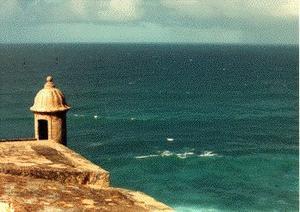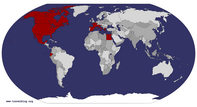Advertisement
Published: November 9th 2006

 San Juan
San Juan
San Juan, San Juan - Puerto RicoMar 15, 1993
*
City official name :San Juan
*
Founded date : *
Location :San Juan Municipality
*
Elavation :? ft (? m)
*
Area :Approximately ? square miles (? km²).
*
Facts :San Juan (sahn HWAHN) is the capital and largest city in Puerto Rico, located in the Northern Coastal Plains region in the karst zone, north of Aguas Buenas and Caguas; east of Bayamón; and west of Carolina and Trujillo Alto.
The city is named after Saint John the Baptist (Spanish: San Juan Bautista). The latest census estimates place the city's population at 433,733, making it the 42nd-largest city under the jurisdiction of the United States. It is also the oldest European settlement in United States territory.
San Juan was founded by Spanish colonists in 1521 and is the oldest city in Puerto Rico. Today, San Juan serves as Puerto Rico's most important seaport, as well as the main manufacturing, financial, cultural, and tourist center of the island. The population of the metropolitan area, including San Juan and the municipalities of Bayamon, Guaynabo, Cataño, Canovanas, Caguas, Toa Alta, Toa Baja, Carolina and Trujillo Alto is about 2 million inhabitants, hence about half the population of

 San Juan
San Juan
San Juan, San Juan - Puerto RicoPuerto Rico now live in this area. The main airports serving the city are Luis Muñoz Marín International Airport, located in Carolina and Fernando Ribas Dominicci Airport located in the Isla Grande district of the Municipality of San Juan.
In 1508 Juan Ponce de León founded the original settlement, Caparra (after the Caceres (province), Spain birthplace of the then-governor of Spain's Caribbean territories, Nicolas de Ovando), today known as the Pueblo Viejo sector of Guaynabo, behind the almost land-locked harbor just to the west of the present San Juan metropolitan area. A year later, the settlement was abandoned and moved to a site which was called at the time Puerto Rico, a name that evoked that of a similar geographical feature in the island of Gran Canaria, Canary Islands, which meant "rich port" or "good port". In 1521, the newer settlement was given its formal name of "San Juan Bautista de Puerto Rico", following the usual custom of christening the town with both its formal name and the name which Christopher Columbus had originally given the island, honoring John the Baptist. The indistinct use of "San Juan Bautista" and "Puerto Rico" for calling both the city and the island

 San Juan
San Juan
San Juan, San Juan - Puerto Ricoled to a reversal in practical use by most inhabitants: by 1746 the name for the city (Puerto Rico) had become that of the entire island, while the name for the Island (San Juan Bautista) had become the name for the city.
In Spanish colonial times, most of the urban population resided in what is known now as Old San Juan. Old San Juan is located on the western half of a small island (the Isleta de San Juan) connected to the mainland by bridges and a causeway. The island, which comprises an area of 47 sq. mi./122 km²., also hosts the working class neighborhood of Puerta de Tierra, which is also the site of most of Puerto Rico's central government buildings, including the commonwealth's capitol.
The old city is the main cultural tourist attraction for Puerto Rico, and the bay side is lined by slips for large cruise ships. The core old city is characterized by its narrow cobblestone streets and colonial buildings, and encompasses less than a mile by a mile and a half.
The buildings in Old San Juan date back to the 16th and 17th century. Parts of the old city remain partly

 San Juan
San Juan
San Juan, San Juan - Puerto Ricoenclosed by massive walls and contains several defensive structures and notable forts, such as Fort San Felipe del Morro (begun 1539) and Fort San Cristóbal (17th century), both part of San Juan National Historic Site, and El Palacio de Santa Catalina, also known as La Fortaleza (begun in 1533), which serves as the governor's mansion. Other buildings of interest predating the nineteenth century are the Ayuntamiento or Alcaldia (City Hall), the San Jose Church (1523) and the adjacent former Dominican monastery; and the former house of the Ponce de Leon family known as Casa Blanca.
Other buildings of interest from Spanish colonial times, among many, are the Teatro Tapia, the Ayuntamiento (City Hall), the former Spanish barracks (now museum de Ballaja), La Princesa (former municipal jail, now a history museum), and the municipal cemetery of Saint María Madgalena de Pazzis, located just outside the city walls.
Also on the island where Old San Juan is situated is the Cathedral of San Juan Bautista (begun in the 1520s), which contains the tomb of the Spanish explorer and settlement founder Juan Ponce de León. Strict building codes enforce restoration.
San Juan was used as a stopover for ships returning

 San Juan
San Juan
San Juan, San Juan - Puerto Ricofrom Spain, making it an important port in the Spanish system. However, this also made it the target of the foreign powers of the time. The Spanish built a network of fortifications to protect the transportation of gold and silver from the New World to Europe.
The city saw attacks from the English in 1595 by Sir Francis Drake and 1598 led by George Clifford, Earl of Cumberland. The artillery from the fortification of El Morro repelled Drake, however Clifford managed to land troops and lay siege to the city. A few months into the British occupation, Clifford was forced to abandon his expedition when his troops began to suffer from exhaustion and sickness. Later, the city was sacked by the Dutch forces, lead by Boudewijn Hendricksz, in 1625, but Fort San Felipe del Morro withstood the assault and was never taken. The English returned in 1797, during the French Revolutionary Wars, led by Sir Ralph Abercromby, who had just conquered Trinidad. His army laid siege to the city but was forced to withdraw in defeat as the Puerto Rican defenses proved more resilient than those of Trinidad. Various events and circumstances, including liberalized commerce with Spain, opening of

 San Juan
San Juan
San Juan, San Juan - Puerto Ricothe island to immigrants, and the colonial revolutions, led to an expansion of the island and city in the late 18th and early 19th century.
In 1898, United States troops bombed, shelled and subsequently occupied the city during the Spanish-American War. Spanish rule ended after 1898 and the island became a territory of the United States of America.
During the 20th century, the main population centers surged well beyond the walls of the old city, onto Puerto Rico's main island, and merged with existing settlements east and south of Old San Juan. As a result, the city now incorporates a diversity of neighborhoods.
East of Old San Juan lies the hotel and condominium filled district of Condado, which lies in land that used to be owned by Pablo Ubarri y Capetillo, Spanish railroad developer and Count of San José de Santurce under the Spanish colonial period. Beaches popular with swimmers and surfers are present all along the district's Atlantic coastline. On December 31, 1986, 97 people died in a fire set by disgruntled employees at the Dupont Plaza Hotel, near the Condado's geographical center.
Near Condado are two separate business districts, Santurce and Miramar. Miramar is

 San Juan
San Juan
San Juan, San Juan - Puerto Ricomainly a residential area rising south of the Condado Lagoon. It comprises the former barrio of Miraflores, as well as drained marshland and landfill in which San Juan's first airport, the Isla Grande airport (proper name: Fernando Luis Ribas Dominicci Airport) was erected. Miramar now hosts the Puerto Rico Convention Center, as well as some of San Juan Harbor's cruiseship piers.
Santurce, originally named San Mateo de Cangrejos (Saint Matthew of the Crabs), was a settlement for freed African slaves during the early days of the city. After Pablo Ubarri sought permission to link Santurce with San Juan proper via trolley in 1878, the township was split in three parts and its main settlement merged with the city and renamed using the Spanish spelling of Santurtzi (Saint George in Basque), Ubarri's birthplace in Vizcaya, Spain. The "Museo de Arte de Puerto Rico" (Art Museum of Puerto Rico) is located in Santurce.
South of Santurce is one of its former barrios, Hato Rey, which was grazing ground for cattle owned by the royal government (hence its name, the King's Herd in Spanish) as early as the 16th century. Hato Rey is now considered the financial center of the island.

 San Juan
San Juan
San Juan, San Juan - Puerto RicoA section of this district is often referred to as the "Golden Mile" (actually 0.47 miles long), due in part to the many banks and businesses located there.
In the southern part of the city is the mostly residential area of Río Piedras. Río Piedras was a separate town, founded in the mid 1850's, which hosted sugar cane plantations and the estates of some of San Juan's wealthiest inhabitants (as well as their working class staff). The Spanish colonial governors also had their summer home there, in land which eventually gave way to the main campus of the University of Puerto Rico. In 1951 the municipalities of San Juan and Río Piedras were merged to delimit San Juan's current city limits. Today Río Piedras, home to a renowned traditional Plaza Del Mercado, is known as the most typically Latin American section of San Juan.
As with many large metropolitan areas, automobile traffic congestion has been a growing concern in the city which prompted city planners to build a metro system dubbed "Tren Urbano" (The Urban Train) which is now in operation.
Advertisement
Tot: 0.33s; Tpl: 0.013s; cc: 21; qc: 90; dbt: 0.1787s; 1; m:domysql w:travelblog (10.17.0.13); sld: 1;
; mem: 1.3mb















